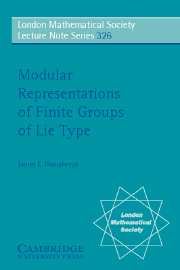Book contents
- Frontmatter
- Contents
- Preface
- 1 Finite Groups of Lie Type
- 2 Simple Modules
- 3 Weyl Modules and Lusztig's Conjecture
- 4 Computation of Weight Multiplicities
- 5 Other Aspects of Simple Modules
- 6 Tensor Products
- 7 BN-Pairs and Induced Modules
- 8 Blocks
- 9 Projective Modules
- 10 Comparison with Frobenius Kernels
- 11 Cartan Invariants
- 12 Extensions of Simple Modules
- 13 Loewy Series
- 14 Cohomology
- 15 Complexity and Support Varieties
- 16 Ordinary and Modular Representations
- 17 Deligne–Lusztig Characters
- 18 The Groups G2(q)
- 19 General and Special Linear Groups
- 20 Suzuki and Ree Groups
- Bibliography
- Frequently Used Symbols
- Index
19 - General and Special Linear Groups
Published online by Cambridge University Press: 23 November 2009
- Frontmatter
- Contents
- Preface
- 1 Finite Groups of Lie Type
- 2 Simple Modules
- 3 Weyl Modules and Lusztig's Conjecture
- 4 Computation of Weight Multiplicities
- 5 Other Aspects of Simple Modules
- 6 Tensor Products
- 7 BN-Pairs and Induced Modules
- 8 Blocks
- 9 Projective Modules
- 10 Comparison with Frobenius Kernels
- 11 Cartan Invariants
- 12 Extensions of Simple Modules
- 13 Loewy Series
- 14 Cohomology
- 15 Complexity and Support Varieties
- 16 Ordinary and Modular Representations
- 17 Deligne–Lusztig Characters
- 18 The Groups G2(q)
- 19 General and Special Linear Groups
- 20 Suzuki and Ree Groups
- Bibliography
- Frequently Used Symbols
- Index
Summary
In this chapter we look at some special features of representations of GL(n, q) and SL(n, q), most of which involve the natural action on the polynomial algebra S := K[x1, …, xn] (19.2–19.7). For example, the ring of invariants has been studied since the time of Dickson. In the case of SL(2, q) there is an interesting “periodicity” phenomenon (19.8), which shows a systematic pattern in the module structure of the homogeneous summands of S. The polynomial ring setting lends itself to combinatorial methods involving partitions, generating functions, and the like. Since algebraic group methods often remain in the background, we provide mainly a survey of the results with occasional proofs when these are self-contained.
To conclude the chapter, we discuss in 19.11 a method of passing from modular to ordinary representations called “Brauer lifting” which in a sense reverses the earlier procedure of reduction modulo p.
Although these topics can be studied in purely algebraic terms, they have many connections with problems in algebraic topology, involving especially the Steenrod algebra and classifying spaces: see for example Wilkerson and Henn–Schwartz. Often the prime p = 2 is most natural in these contexts, but the algebraic framework is more general.
- Type
- Chapter
- Information
- Modular Representations of Finite Groups of Lie Type , pp. 197 - 204Publisher: Cambridge University PressPrint publication year: 2005



